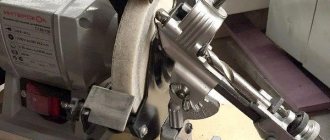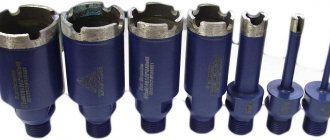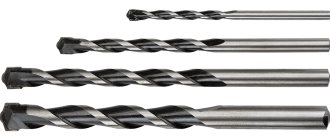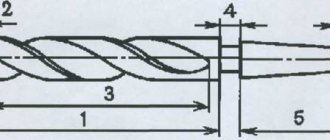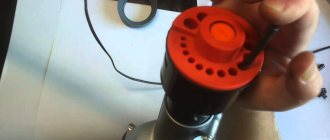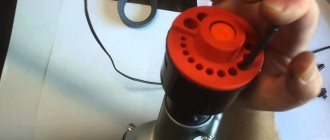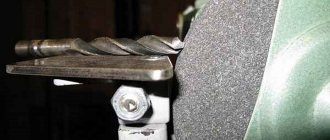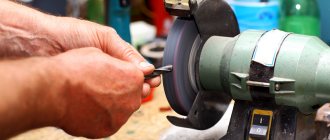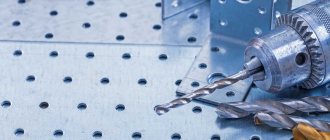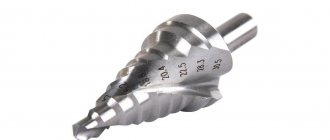Drills are designed to create holes in the material - both through and non-through (recesses). Drills are produced for a wide variety of materials that are used in production and everyday life: for wood and its composites, metal, concrete, plastic, stone, etc. Drilling occurs as a result of translational (along the axis) and rotational movement of the drill. The material is cut using cutting edges, which can have different configurations and sharpening angles. Subtypes of drilling include drilling (making a blind hole) and reaming (expanding an existing hole to a larger diameter). There are many types of drills, differing in purpose, configuration of the working surface, manufacturing method, type of material for which they are intended, etc.
Types of drills depending on the shape of the working surface
Screw or spiral.
The most popular drill, used for drilling a wide variety of materials. The length of the twist drill can reach 28 cm, diameter – 80 mm.
Flat or feather.
Used for drilling mainly deep, large-diameter holes. The working part has the shape of a blade, in the center of which there is a protruding point for centering. The blade can be integral with the shank or be replaceable and attached to the rod using a holder or boring bar.
Drill for deep drilling.
Designed to make holes whose depth is at least 5 times greater than the diameter. The deep drill has two screw channels through which a cooling emulsion is supplied to the cutting area. The channels can be located inside the drill or in soldered tubes.
Single cut drill.
Used for drilling holes that require increased accuracy requirements. Single-cut drills have a reference plane and two cutting edges located on one side of the center.
Core bit or annular drill.
It looks like a hollow cylinder. Cutting is carried out by the cylinder wall on which the cutting edge is located. Drilling is obtained in the form of a ring, inside of which there is untouched material (core). After drilling, it usually remains in the crown; you just need to shake it out.
Center drill.
It is used to drill (mark) the center.
Step drill.
A relatively new type of instrument. They are convenient for drilling sheet material, especially in cases where you need to get a large hole in diameter - up to 3.5 cm or more.
According to the shape of the resulting hole, drills are divided into conical, cylindrical and stepped.
Let's look at the pros and cons of the tool
| Purpose | Form | pros | Minuses |
| For metal | Conical | Allows you to carry out work in one stage | Not suitable for low power drills |
| Stepped | Suitable for creating recesses of different widths. One pass drilling is enough | Used only for sheet metal having a thickness of no more than 2 mm | |
| Spiral | Reliable, retains sharpness well | Requires the use of products of different thicknesses to create the desired hole diameter | |
| Crowned | Suitable for creating large recesses over 30mm wide | Not compatible with conventional drills | |
| On wood | Hole saws | Can be used for PVC lining, expanded polystyrene and cellular polycarbonate | Installing socket boxes in surfaces made of OSB or lining requires finishing the hole with a jigsaw |
| Spiral for wood | Allows you to obtain high-quality recesses without torn fibers | Limited scope | |
| Screw | Provides a neat and clean cut, even on damp wood | ||
| Ballerinas | Allows you to adjust the diameter of the future hole | ||
| Feathers | Produces clean edges without torn wood fibers | When creating a hole of small depth, a groove from the tip remains in its central part. The tool only works at low speeds | |
| Forstner drills | Allows you to create recesses with neat edges and a flat bottom | ||
| For concrete, brick and stone | Spiral | Works well with concrete and brick | |
| Crowned | Do quality work | Requires hammer drilling and is therefore not suitable for standard drills | |
| Screw | The design provides good dust removal | ||
| For tiles and glass | Crowned | Large diameter range | Requires a smooth touch to the surface, without runout or uneven pressure |
| Feathers | Strength of alloys in construction | Small selection of drilling diameters |
Shank types
Depending on the shape and method of fastening in the chuck or spindle, shanks are:
- cylindrical - the outer surface has the shape of a cylinder;
- conical - the surface is made in the form of a cone;
- faceted - there are 3, 4 or 6 edges on the outer surface;
- SDS type – shank for mounting in a chuck with a special locking mechanism.
The most common cylindrical drills in everyday life are fastened in a conventional chuck. Tools with a tapered shank are designed for use on machine tools. The SDS type shank is designed for mounting in a rotary hammer.
Types of products by purpose
The main differences between the components are the angle of sharpening, the shape and type of cutting edge. Many components have a limited area of application.
According to their purpose, they can be divided into several categories, including interaction with surfaces from:
- Wood
- Tiles and glass
- Metal
- Concrete, brick and stone
On wood
When working with wood, a standard spiral tool for metal structures is usually used. It is suitable for holes measuring 0.2-1.8 cm. But when processing wood, these capabilities are not enough.
Several special parts have been developed to expand the scope of action:
- Hole saws
- Spiral for wood
- Screw
- Ballerinas
- Feathers
- Forstner drills
Hole saws are elements with a standard drill located in the center and a hollow cylinder framing it, covered with teeth at the end. They are used to drill lining, plywood and boards. This is a good option for installing lamps, since the size of the recesses is quite wide (2-6 cm). Hole saws are also suitable for cutting into sockets if the base is made of foam concrete, wood or clay. In this case, you can sample the material using a chisel.
Spiral models are in many ways similar to similar nozzles for metal, but have a different shape of the cutting part. It looks like a trident. The central point is fixed in the required place with high precision and enters the wood without any problems.
Screw-type drills are equipped with an improved working component for removing chips. The long length of the products allows you to drill deep recesses. This tool is often chosen for logs and beams. The tip of the device is similar to a screw and penetrates well into the wood, pressing the cutting part against the fibers.
Expert opinion
Levin Dmitry Konstantinovich
Many varieties have a handle that allows you to do the work without using a rotator, hammer drill or machine.
Ballerina shoes - options with a key to adjust the gap between the incisors. They can create large diameter notches in MDF, chipboard, OSB and plywood. The design includes a cross with a spiral drill in the middle. The sharp cutters on the arms of the piece can easily cut through metal sheets.
Feathers are flat elements with a trident at the end. This variety gives a larger drilling width, but can be attached to a standard drill. It is often chosen for hand cranking.
Forstner drills consist of a pair of cutting components mounted on a cylinder-shaped shank. They are in demand in the manufacture of furniture. They create large recesses to accommodate cabinet door hinges.
For tiles and glass
Two types of parts are used for processing glass and ceramic surfaces:
- Crowned
- Feathers
Crown varieties are coated with diamond coating and reach a width of 1.3-8 cm. To perform the task well, you will need a high-quality machine or hammer drill.
The feather parts are made in the form of a standard metal rod with a sharp spear-shaped tip. They create recesses with a diameter from 3 to 13 mm. The cutting edge of the pen is made of pobedite.
To work with glass and ceramics, a selection of high-quality consumables is required. Insufficient sharpening of the cutting element or its unevenness can cause cracks.
For metal
Such drills are mainly used for working with a metal base, but are also used when drilling wood or plastic.
Products may have different designs:
- Conical
- Stepped
- Spiral
- Crowned
Conical models are most often installed in machines. The cone-shaped working part has a pointed top that cuts into the metal. The result of drilling is a thin and neat hole. It expands as the thicker housing component penetrates into the material.
Components with a stepped are among the most modern options. The cone shape has a stepped structure that allows the recess to be gradually expanded.
Spiral – classic components of a standard shape. They include the shank, working part and cutting edge. The latter has a sharp edge that passes well through the metal base. The working element is made in the form of a spiral that frees the hole from accumulating chips. The tail zone is fixed in the machine niche or drill chuck. In the production of such items, high-speed steel grades H6M5, P18, HSS are used.
Crown varieties consist of an empty cylinder with sharp serrations at the border of the lower end. They process metal sheets with a thickness of no more than 10 mm. They are made from HSS steel. Some options are equipped with carbide brazing or diamond coating. Crown-shaped nozzles perform well when interacting with metal and concrete.
For concrete, brick and stone
Consumables for processing stone, concrete and brick bases have soldering tips for cutting through solid structures, which are made from artificial diamonds or pobedite sheets.
They can be produced in three forms:
- Spiral
- Crowned
- Screw
Spiral elements are inserted into the hammer drill. They are very similar to parts for processing metal structures, but are additionally equipped with soldering. These components are capable of creating holes up to 80-100 mm deep.
Crown-shaped attachments are similar to similar attachments for wood. In the middle there is a drill in the form of a spiral, which cuts well into the surface. But the main drilling process takes place with the participation of a crown equipped with soldering.
Screw components are also equipped with soldering. They are longer than spiral models. Such devices are suitable for creating deep recesses.
Drill manufacturing technology
Drills of relatively small diameters (up to 8-10 mm) are usually made from a solid rod of steel or alloy. The most commonly used high-speed steel grades are P9, P9K15, and P18. Drills of large diameters are made by welding; the cutting part is made of high-speed steel, and the shank is made of ordinary carbon steel.
For drilling hard materials - hardened and alloy steel, stone, concrete - drills are used that have soldered carbide plates made of pobedite or other hard alloy at the end. The cutting edges of the inserts can have different configurations: helical, beveled or straight.
Types of coating
Drills are coated for different purposes: protecting against corrosion, strengthening the surface layer, improving heat transfer, reducing friction. The most common and inexpensive operation is oxidation. The drill is coated with a black oxide film, which protects it from rust and overheating.
Titanium nitride (TiN) coating increases drill life by at least three times. However, such drills cannot be sharpened, since this removes the hardened layer. Titanium carbonitride (TiCN), also used for coating, is similar in properties to TiN.
Titanium aluminum nitride (TiAlN) makes the drill even more durable. When using it, the tool can work 5 times longer than usual.
Diamond coating is considered the most durable coating. This is not surprising. Diamond ranks first in hardness among other materials. Diamond-coated drills can be used for drilling almost any hard material, including stone.
What does the color of the drill mean?
The color of the coating can roughly determine the characteristics of the drill. Regular quality drills have a gray paint characteristic of steel.
Black color indicates that the drill has been oxidized. That is, it is protected from corrosion and has improved heat dissipation properties.
A light golden tint indicates that the drill has undergone a tempering procedure, during which internal stresses are relieved.
The titanium nitride coating reveals itself with the bright shine of gold. Drills with it have an increased service life and low friction when drilling. Although they are more expensive, they more than justify their price with long-term operation.
Diamond coating can be recognized by its yellow color and powdery texture.
How to distinguish the quality of a drill by color
Pay attention to the color of the material from which the drill is made: it is the first clue about the strength of the tool.
- The gray color indicates that this is an ordinary drill of medium strength. It is quite suitable for single drilling, but will not cope with a large volume of work.
- Black - indicates that the steel has been treated with superheated steam, which guarantees a higher quality of the product.
- A golden hue is a sign that during the manufacturing process of the drill, a procedure was carried out to relieve the internal stress of the steel.
- The bright gold color indicates a high degree of strength and reliability of the instrument. Surface treatment with a titanium compound significantly reduces the friction of the working part of the drill during operation, which has a positive effect on extending its service life.
- The cost of drills increases in the same order in which they are listed. Having decided on the preferred color, let's move on to the purpose of the tool.
Metal drills
For drilling metals (steel, cast iron, non-ferrous alloys), twist drills are usually used. Their longitudinal grooves do a good job of removing chips generated during drilling.
The processed materials have different hardness. Therefore, to drill them, drills with different hardness of the working part must be used. To process hardened, alloyed, heat-resistant steels, it is necessary to use solid carbide drills or those that have soldered carbide plates at the tip.
Product Features
Drills for hammer drills and machine tools, which have a spiral shape, are the most popular today. This is due to their special characteristics. They are well aimed in the hole and also have a large margin for regrinding. Due to the design features, such a cutter removes chips well and easily supplies lubricants to the working surface. These features make this type of drill very popular.
To correctly designate geometric parameters, there are special notations. The diameter of the drill can be very different. However, the designations remain the same. The tip angle at the apex is referred to as 2φ. The inclination of the grooves is denoted by the letter ω, and the end transverse edge is denoted by ψ. The front angle in the drawings is referred to as γ, and the rear angle as α.
Together, these indicators are called drill geometry. It reflects the position of the grooves, cutting edges, as well as their inclination angles.
Wood drills
Relatively small holes up to 12 mm in wood or wood composites (chipboard, MDF) can be drilled with a conventional metal twist drill. But holes that are subject to increased requirements for dimensional accuracy and surface cleanliness are made with drills specially designed for wood. They are made from tool or carbon steel and are not suitable for metal.
Twist drills.
Designed for drilling small and medium-sized holes. As already noted, you can use twist drills for metal instead, but the holes after them are of poorer quality.
Screw drills.
They have a sharp cutting edge and a screw-like shape. Thanks to the latter, chips are easily removed from the hole. These are high-quality drills that are used if you need to get a deep hole with a smooth wall.
Feather drills.
They are used to produce holes of relatively large diameters - from 10 to 25 mm or more. These are the simplest and most inexpensive drills, you can even make them yourself from a suitable plate and a round rod. But the quality of the holes after them is low - rough walls, not very accurate dimensions.
Crown.
The term “crown” means that this tool is made in the form of a hollow cylinder, on the edges of which there are teeth. The drilling is obtained in the form of a ring, from which the inner part is then removed. A crown is an indispensable tool if you need to get a large hole - up to 100 mm or more. In stores it is offered in the form of a set, which contains a mandrel, a centering drill with a shank and several crowns of different diameters.
Forsner drill.
This is a tool for making precise holes in wood (especially soft wood), chipboard, laminate, etc. It has a centering point and a sharp-edged scorer. Thanks to the latter, the hole is precise and smooth. If you need to get a blind hole with smooth walls and precise dimensions, a Forsner drill will do the job best.
The best manufacturers
Among Russian manufacturers of drilling tools for metal work, the products of the Volzhsky Tool Plant (VIZ) and Tomsk Tool Plant have a good price-quality ratio. The tools of the Ukrainian Zaporozhye Tool Plant (ZIZ) belong to this category. The best quality drills are from world-famous manufacturers of cutting tools, such as German Bosch, Hasser and Ruko, Swedish Sandvik, Japanese Mitsubishi, Taiwanese Winstar, etc. But their products have a fairly high price and are intended mainly for professional use. In addition, metal drills are widely available on the market under the trademarks of well-known sellers and manufacturers of power tools. Basically, this is an inexpensive tool, but many products are of very high quality. In this category, users most often refer to Interskol, DeWalt, Hilti, Makita and Metabo.
Drills for stone materials
Conventional metal drills are not suitable for drilling brick, concrete, natural or artificial stone. They instantly become dull. A drill or drill for stone materials must have a carbide tip.
The operation itself of drilling concrete, brick or stone also has its own peculiarities. In addition to the rotational movement, the drill or drill inserted into the hammer drill also performs a percussion-translational movement. That is, the stone, in fact, is not cut, but crushed.
A drill or drill bit for a hammer drill can have a regular cylindrical or a special standardized SDS type shank (SDS-top, SDS-max or SDS-plus). Its advantage is that the insertion and removal of the drill from the chuck is carried out without a key and very quickly, in one movement.
Small and medium-sized holes in brick and concrete are drilled with a drill or a drill with a carbide tip. The tool has the shape of a screw.
If you need to drill a large hole, then use a crown with carbide teeth or diamond coating. Drilling can be wet (with water supplied for cooling) or dry. At the end of drilling, a core remains inside the crown - a cylindrical piece of cut material.
Carbide inserts soldered to a drill or auger have different hardnesses. For drilling granite, drills with high-hardness pobedite plates are used. For working with concrete or brick, medium or soft hardness Pobedit grades are suitable.
Geometry and elements of cylindrical metal drills
Cylindrical metal drill: main types and scope of application. Design features and main elements of twist drills: working part, shank, neck. Shank types: cylindrical and conical. Applicable GOSTs.
The metal cylindrical drill is the most well-known tool for making holes. The history of devices dates back to 1867, when the American Morse company presented the first tool at the World Trade Exhibition. To this day, the design of cylindrical drills has remained virtually unchanged - the main changes relate to the structural materials used.
In this article we will look at a variety of screw-type drilling devices that are used to make through and blind holes in metal products.
Drills for ceramics and glass
Ceramic tiles or glass are drilled with a crown or a special spear-shaped tool. Its tip is made of either pobedite or tungsten carbide. If a specialized tool for glass or tiles is not available, you can use a concrete drill. It just needs to be sharp, and you need to work with it carefully, since its shape is not entirely suitable for such work.
Spear drill bit for ceramic tiles and diamond-coated bit.
A crown for glass and tile is almost no different from a crown for stone. Only on its cutting edge instead of teeth there is a diamond coating.
A tool called a ballerina is used to drill large holes in tiles. It resembles an ordinary compass. Drilling is done from the underside of the tile. The drill speed is set to minimum.
Universal drills
In addition to the above specialized drills, there are also universal ones. They can process almost any materials - brick and concrete, tiles, wood, plastic, aluminum, steel. Universal drills have a clever sharpening that is capable of cutting any material. This is very convenient in cases where you have to work with different materials simultaneously. For example, when renovating an apartment.
